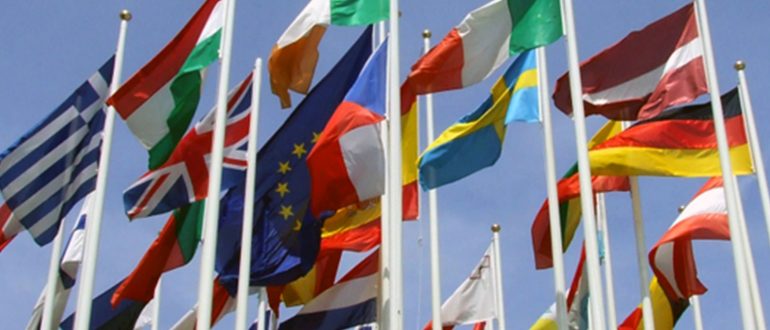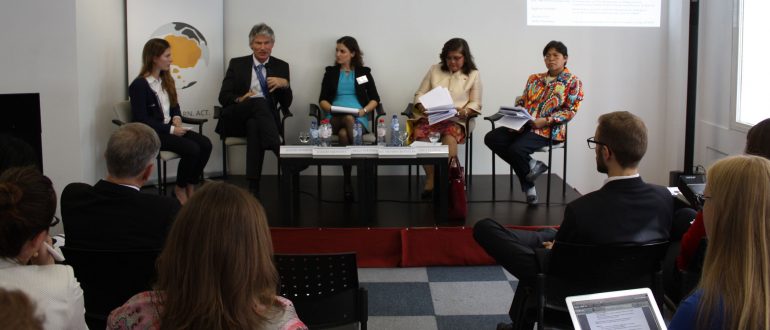Community Building in the Asia Pacific – A New Role for the Expanded East Asia Summit?
When Asian leaders convene in November to hold the sixth East Asia Summit (EAS) in Bali, presidents Dmitry Medvedev and Barack Obama will be representing their countries as full-fledged members for the first time. What are the implications of Russia’s and the U.S.’ accession for Asia’s fledgling regional architecture? As this article outlines, the accession of the two major powers can boost Asia Pacific multilateralism – if it is managed well by the smaller states.
1. Introduction
In the wake of the proliferation of multilateral bodies the Asia Pacific has seen since the 1990ies, the East Asia Summit (EAS) was launched in 2005 by the ASEAN Plus Three (APT) countries as an annual meeting of regional leaders, heads of state and government, to discuss strategic, political and security matters in a broader framework. The APT process includes the ASEAN countries (Brunei, Cambodia, Indonesia, Laos, Malaysia, Myanmar, the Philippines, Singapore, Thailand and Vietnam) as well as China, Japan and South Korea.
From the beginning, questions of membership played a key role due to strategic considerations and competing models of regional community building. While China envisaged the EAS to be a truly East Asian forum and thus supported a more exclusive format based on the APT member states, Japan pushed for the inclusion of Australia, New Zealand and, later, India in accordance to its vision of a community drawing upon an “ASEAN Plus Six” model.
With the ASEAN states wary of Chinese dominance in the future regional architecture, and with Chinese leaders careful not to nourish their neighbors’ suspicions, Japan was able to push through the admittance of the three countries – at the cost of China’s temporary loss of interest in the forum. For the time being, the Chinese leadership seems to have identified the APT as the preferred framework to promote regionalism in Asia.
Against this backdrop, the accession of Russia and the U.S. might set off a new dynamic in the ever-advancing, but sometimes incoherently mushrooming process of institutionalizing multilateral politics in the region. It seems clear that the EAS only works as an effective body for regional dialogue if its membership is soundly balanced. This being said, what are the implications of Russia’s and the U.S.’ accession for the relevance of the summit in Asia’s regional architecture?
Any answer to this question has to consider two parameters. First: What are the new members’ stakes in Asian community building through the EAS? And second: How will the other member states respond to their accession?
2. U.S. and Russian interests in Asian community building
Even during the 1990s, when some observers accused the United States of neglecting the region, America never ceased to be the prime power in the Asia Pacific, guaranteeing stability through a system of bilateral military alliances. Notably, under Barack Obama, the self-declared “first Pacific president”[1], the U.S. has tried to invigorate the multilateral dimension of its Asia strategy. The rationale here seems to be to engage China in a regional architecture and thus ease the impact of its rise while at the same time ensuring America’s own influence in the region. Consequently, the U.S. has come to actively support community building in the Asia Pacific. With the Asia Pacific Economic Cooperation (APEC) clearly lacking the drive to advance the integration process, America is wise to turn its attention to the EAS, where it can deal with all the major powers, including India, which is not a member of APEC.
Russia, much like the U.S. though earlier, has adopted an eastward-looking policy of fostering cooperation with its Asian neighbors. In fact, then-president Vladimir Putin was invited to join the first EAS in 2005 as a guest. The main pillar of Russia’s relations with Asia is its partnership with China. Sino-Russian ties have been strengthened in the last years, in spite of smoldering conflicts, particularly through the Shanghai Cooperation Organization (SCO) which brings together the two giants with four Central Asian states and which has been dubbed the Anti-NATO by some observers. While the SCO is genuinely a forum for security cooperation, Russia’s interest in East Asian community building is likely to be mainly economic in nature. As the world’s largest oil exporting nation, it wants to ensure access to Asian markets whose demand for energy is ever-increasing.
3. The Asian powers’ response to U.S. and Russia as new EAS members
a) China
How China will respond to the enlargement of the summit is unclear. It might seem a natural consequence of the U.S. entry into the summit that China will further shift its multilateral efforts from the EAS, where it is confronted with major competitors such as the U.S. and India, to the more exclusive APT where it can exercise leadership as the strongest member. In fact, quite the opposite may prove true: Asian regionalism is not a simple zero-sum game of who dominates what grouping or who can push through his idea of regional integration. To be sure, the U.S., China and Japan all favor one mechanism over the other (APEC, APT and EAS respectively) to pursue their respective interests. But actually, the functional focus of the fora is varying from free trade (APEC) to financial cooperation (APT) to strategic dialogue (EAS). Of all countries, China has a genuine interest in using multiple channels to spread the narrative of its peaceful rise and benign motives regarding its neighbors. It might also welcome the new EAS as a framework that allows its president to discuss strategic issues with his American counterpart without Taiwanese officials at the same table, as is the case in APEC. For these reasons, it is well possible that the EAS will receive renewed attention from Beijing – even though bilateral channels will most likely remain its preferred instrument for regional diplomacy.
b) Japan
Due to its close ties with the United States and its intensive trade, Japan has always been inclined to a more Pacific outlook in Asian regionalism. In Tokyo’s view, the move to include the U.S. can only serve the country’s interests by balancing China and by supporting Japanese claims in territorial disputes with its neighbors – although China, who competes with Japan over the Senkaku/Diaoyu Islands, has so far declined American proposals to discuss the conflict in multilateral frameworks. The fact that the U.S. now is a part of the EAS is likely to foster the impression in Tokyo that America supports Asian community building and thus buttresses Japanese efforts within the summit process.
As to Russia, the Japanese record is more mixed. Tokyo is benefiting from the ESPO pipeline system pumping oil to Japan, but so are South Korea and China. The strong competition between the Northeast Asian countries for Russian oil made it obvious to Japan that cooperation on energy security in the EAS has to include Moscow as the main supplier. On the other hand, tension remains high in the conflict over the Kuril Islands and, given Russia’s stubborn stance on the issue, it is unlikely that the EAS can serve as a place to effectively tackle it.
c) India
Similar considerations apply for India, whose “Look East” policy has led it to engage with its eastern neighbors and support the region’s integration process. New Delhi is anxious about Chinese activity in the Indian Ocean and it has during the last years stepped up its relations with the U.S., peaking in the 2007 nuclear deal. India hopes to further strengthen ties with the U.S. through the EAS, thus hedging against possible Chinese hegemonic ambitions. It shares the view of the ASEAN states that to guarantee stability, major powers like itself, Russia and the U.S. should have a stake in the region. Consequently, it has supported the extension of the summit.
d) ASEAN members
Of the established EAS members, the ten ASEAN states were among the strongest supporters of the enlargement. This comes as no surprise since the Southeast Asian nations are the ones most directly concerned with Chinese ascendancy. To balance growing Chinese influence in Southeast Asia, ASEAN states are trying to draw the United States into Asia’s security dialogue. At the same time, the organization wants to remain in the “driver’s seat” of East Asia’s community building process. In this respect, managing the EAS might prove a balancing act. Letting the U.S. join might prevent the Chinese from dominating the forum, but what will the Chinese response be? And will ASEAN continue to be the driving force of the EAS? Or will it lose influence amidst great power politics? The organization will have to play its part as a broker very well if it wants to remain the motor of Asian integration.
4. Conclusion
As this article has pointed out, all of the major players have a stake in community building. Still, in the face of continued suspicion, rivalry and nationalism, the task of creating an East Asian Community may seem overwhelming. Much depends on how China responds to the new framework. If ASEAN manages to mitigate Beijing’s suspicions, the EAS can serve as a building block for further cooperation. Still, one should not get one’s hopes up too high. Multilateralism in Asia does not work the way it does in the Western world, with strong formal institutions being rare. After all, the EAS may come to be little more than another talking shop. But in a region historically so prone to military conflict, getting all the relevant parties at a table to build mutual trust is not so bad. As the renowned scholar of Asian relations, Amitav Acharya, argues, the most important contribution of multilateralism to Asian security is norm proliferation. In this respect, the expansion of the EAS shows all relevant players commit themselves to Asian style multilateral dialogue and peaceful settlement of disputes – a precious signal in times of rising tension in the Asia Pacific.
by Kilian Spandler
Kilian Spandler is studying political science, sociology and economics at Würzburg University.
Image Source
http://upload.wikimedia.org/wikipedia/commons/3/3b/East_Asian_Community.PNG, accessed 09/30/2011.
Bibliography
Acharya, Amitav (2003): “Regional Institutions and Asian Security Order. Norms, Power, and Prospects for Peaceful Change”. In: Muthiah Alagappa (ed.): Asian Security Order: Instrumental and Normative Features, pp. 210-240.
US, Russia to Join East Asia Summit (AFP, 07/20/2011, http://www.google.com/hostednews/afp/article/ALeqM5h3xcrO8YSIm9-PeBMNAC-i5PMfcw, accessed 30/09/2011).
Chachavalpongpun, Pavin (2010): How the US Plays into the East Asia Summit for ASEAN (http://www.eastasiaforum.org/2010/08/17/how-the-us-plays-into-the-east-asia-summit-for-asean/, accessed 09/30/2011).
Cook, Malcolm (2008): “The United States and the East Asia Summit: Finding the Proper Home”. In: Contemporary Southeast Asia 30:2, pp. 293-312.
Chye, Tan Seng (2010): Big Power Rivalry in East Asia: Will It Disrupt Regional Cooperation? (RSIS Commentaries No. 144, http://www.rsis.edu.sg/publications/Perspective/RSIS1442010.pdf, accessed 09/30/2011).
Jannuzi, Frank (2008): US Perspectives on East Asia Community Building. In: Jusuf Wanadi/Tadashi Yamamoto (eds.): East Asia at a Crossroads. Tokyo, pp. 90-104.
Kapila, Subhash (2006): Russia’s Foreign Policy in a Resurgent Mode: An Analysis (South Asia Analysis Group, Paper No. 1682, http://www.southasiaanalysis.org/%5Cpapers17%5Cpaper1682.html, accessed 09/30/2011).
Kuala Lumpur Declaration on the East Asia Summit (12/14/2005, http://www.asean.org/23298.htm, accessed 09/30/2011).
Emmerson, Donald K. (2010): Asian Regionalism and US Policy: The Case for Creative Adaption (RSIS Working Paper No. 193, http://www.rsis.edu.sg/publications/WorkingPapers/WP193.pdf, accessed 09/30/2011).
Singh, Sinderpal (2010): India and the East Asia Summit: Eastward Ho! (http://blog.nus.edu.sg/southasiansoundings/2010/11/15/india-and-the-east-asian-summit-eastward-ho/, accessed 09/30/2011).
Swaine, Michael D. (2011): America’s Challenge. Engaging a Rising China in the Twenty-First Century. Washington
Wihardja, Maria Monica (2011): Indonesia Should Cross the River by Feeling for Stones (The Jakarta Post online, 05/30/2011, http://www.thejakartapost.com/news/2011/05/30/indonesia-should-cross-river-feeling-stones.html, accessed 09/30/2011).
[1] “Climate Change. Obama vows renewed ties with Asia” (http://articles.cnn.com/2009-11-13/world/obama.asia_1_asia-pacific-pacific-nation-first-asia-trip?_s=PM:WORLD),November 13, 2009.




